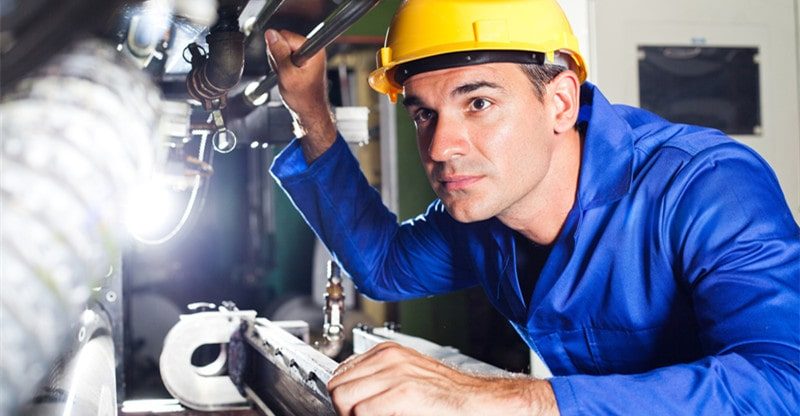Machine Guarding Safety to Learn
Operating cutting machinery without the proper safety measures in place can lead to disaster. Employee injuries can be very expensive. All machinery should have safety protocols in place and the employees operating them should be taught the safe operation of the machinery.
Legally, some machines require safety guarding methods and all machines must follow general safety requirements. OSHA is the government regulatory department for worker safety or Occupational Safety & Health Administration.
Machinery Can Cause Serious Injuries in the Workplace
In the manufacturing sector, moving machine parts can cause serious workplace injuries including dangerous cuts, crushed hands and fingers, amputations, blindness, burns, and other injuries. But these injuries are all preventable with the use of safeguards and safety training. Any part or function of a machine that could cause injury must be safeguarded.
Making a Workplace Safer
Factory owners and other business owners can have a preventative safety evaluation done by a professional safety expert to plan machine guarding safety. A company like Dynatect can help industry employers address and meet OSHA safety standards for the industry. Having this evaluation and following the recommendations it brings can cut down on employee injuries, downtime, and liability exposure.
One safety measure is to add flexible guarding around moving parts and pinch points. Other safety measures include adding physical barriers, torque limiters, and other machine safety controls.
Machine Safety Control Areas
Horizontal Machine Doors
Factories and other commercial places can be retrofitted with horizontal doors with automatic door actuators. These doors will reverse when objects are placed in their path. These door actuators can be added to existing horizontal doors. They have built-in safety functions that help prevent injuries from multiple manual door opening and closing and from crushing.
The door actuator has preprogrammed control features that allow input and output commands:
• Travel distances pre-programmed in
• Self- calibration
• Electric operation rather than manual
• Programmed braking for safety
• Eliminates limit switches, pressure switches, photo eyes, and light curtains
Safety Doors to Separate People from Hazardous Industrial Processes
These special safety doors are used when preventative steps are needed in areas where things like robotic welding, chemical processing, and other work risks exist. The door creates a safety interlock, minimizes the risk of people falling through the door or getting caught in the door as it closes.
Fall Protection
Open pits and other dangerous openings must have walk-on or roll-up covers to prevent falls while offering partial pit access. Roll-up covers of aluminum are lighter weight and more convenient to use than slats or grates which require more support and are inconvenient to move for access.
Wherever there is a fall hazard proper steps must be taken to prevent falls and enhance safety measures.
Hazardous Tank Fume Containment
Chemical tanks or other containers that house dangerous chemicals and can emit harmful fumes must be covered or enclosed. These can be retractable lightweight covers such as polypropylene.
They must withstand damage from corrosive fumes and have automatic controls for lifting or sliding open when needed. They must control heat and chemical evaporation. Some processes linked to this are anodizing, plating, etching, cleaning, and other chemical processes.
Hand and Arm Protection
Even automated machines can experience unplanned obstructions, including access doors, rotating parts, and other obstructions that can cause danger for operators. Mechanical slip clutches can make the machine operation smoother and safer.
Any aspect of machine operation that constitutes a danger for hand or arm injury must be guarded to make it safer.
Pinch Points must be isolated. These include scissors and lift tables, tilt tables, as well as other mechanisms that can cause injury if not guarded by enclosures or other methods. Heavy-duty accordion-type skirting can be one answer.
Fire and Environmental Protection
Dust and sound containment are important. Large machining and other manufacturing operations generating dust and loud sound must be managed to minimize the effects of the sounds and dust on surrounding areas where people are working. And yet these areas must be easily accessible.
One solution is adding machine or roof type covers that are designed to hold and limit debris and types of airborne contamination. They do not create interference with the manufacturing process.
Engines and motors must be ducted so their exhaust does not cause injury and polite the indoor air where workers are performing their tasks.
Machine Guarding Purpose
There are many hazards to be addressed in the work and manufacturing operations in the U.S.A. Machines that are not guarded properly can do to workers’ bodies what they are meant to do to materials they are meant to cut, form, or shape. In addition, machinery has nip points, rotating parts, and flying sparks, chips, and other debris.
Machine guarding is a term used to describe the process of guarding all machinery to eliminate hazards and reduce workplace injuries. All machinery should have safety guards and other safeguards in place.
There are multiple methods for machine guarding for safety purposes. Some methods of protecting machine operators and employees in the work area from hazards include:
• Barrier guards
• Electronic devices for safety
• Two-hand devices for tripping
• Lockout/tagout procedures for machine maintenance and repair. All power to the machine is turned off and the machine has warning tags placed on it.
The most common machines that require guarding at the point of operation include:
• Shears
• Guillotine cutters
• Alligator shears
• Milling machines
• Power presses
• Power saws
• Joiners
• Forming rolls and calendars
• Portable power tools
• Revolving barrels, drums, and other containers
• Fan blades that are less than 7 for from a floor
It is the responsibility of the owner of the factory or commercial enterprise to maintain a safe workplace meeting OSHA standards and rules. When an unsafe workplace is cited by safety inspectors, it must make changes to ensure worker safety before it can resume operations.
Worker injuries can lead to lawsuits and huge liability issues. A little preventative safety retrofitting can be a very good investment in worker safety and limiting liability in the future.
In these times when it is not easy to get enough qualified workers, a safer workplace can draw new employees or contribute to workers staying on the job instead of looking for safer work. A safer workplace leads to a more productive operation with less downtime and more profits.



